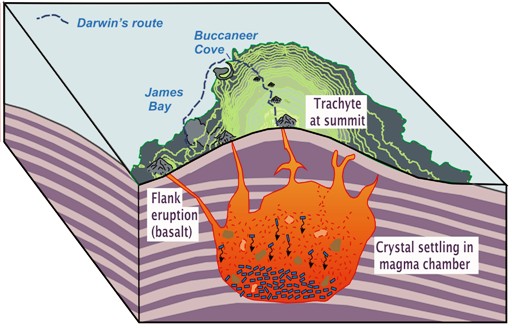
Darwin on Isla Santiago
In 1897, five years after Darwin’s death, his geological specimens from the Galapagos were incorporated by the Woodwardian Museum (now the Sedgwick Museum of Earth Sciences) at Cambridge University (Fig. 5), but by then were treated as historical material rather than being integrated with the general collections. Darwin’s samples of ‘basalt’ and ‘trachyte’ from the Galapagos were examined by Alfred Harker
14 and subsequently in more detail by Richardson
15. Both made full use of thin sections and confirmed much of Darwin’s petrological nomenclature. However, with the exception of work by science historians
16, there have been very few recent attempts to study Darwin’s collection of rocks from the Galapagos. This may be because his samples are small (typically <5cm) and covered in lichen - offering only limited scope for a modern-day petrological study. Yet despite their size, the specimens are highly varied and confirm that Darwin had a keen collector’s eye.
Partly supported by a fieldwork grant from the Society, I participated in two international scientific expeditions (2007, 2008) to the uninhabited Isla Santiago, the fourth largest island (585 km
2) lying at the centre of the archipelago and consisting of a large alkaline shield volcano to the west and predominantly tholeiitic monogenetic cones to the east. Only one pioneering geological expedition17 and one detailed field investigation
18 had previously been attempted there, and one of our main goals was to locate Darwin’s route and the places from which he drew inspiration.
The expedition to the north-west of Isla Santiago (2007) visited the sites at Buccaneer Cove described in Darwin’s notebook and Volcanic Islands. His field notes are not always easy to follow and it was only once we had visited and collected samples from most of Darwin’s localities that we became aware of systematic discrepancies between these two references.
For example, we sampled what we believe to be Darwin’s ‘200 ft’ lenticular mass (a solidified lava lake) on the promontory (Fig. 3). The lava is highly vesicular and contains numerous plagioclase crystals (it is a trachyandesite). In the field, Darwin described this as trachyte; but in Volcanic Islands (1944) he reclassified it as basalt. Also, some of our observations differed from Darwin’s. The precipitous cliffs that form the promontory are ~200ft high but the lava lake itself is closer to 50ft thick. Since this is the only lens-shaped body on the promontory and occurs in the centre of what was once a volcanic crater just as Darwin says, we concluded that Darwin probably later confused the lava’s thickness with his estimate of cliff height.
We also visited Darwin’s xenolith (ejected fragment) locality at the north end of Buccaneer Cove. This is one of the few places where he drew a sketch, and it can be recognised today (Fig. 4) despite the lack of any scale. (It is interesting that the sketch was reversed in Volcanic Islands.) Darwin’s xenolith samples are all heavily oxidised (reddened), making the constituent phases difficult to identify in hand specimen. This may account for his incorrect field identification of these as granites16. On his return to England he realised they contained no quartz6 (thin sections of his samples show that they are in fact gabbros). We found similar reddened xenoliths in thin lavas at Buccaneer Cove but also located abundant fresh gabbro xenoliths in a small bay north of the promontory. It seems that Darwin did not go there, which is unfortunate because here the lavas display a clear relationship between their crystal content (olivine-, pyroxene- or plagioclase-rich) and the type of xenolith that they contain. The xenoliths appear to represent a crystal pile, dredged by different eruptions. Disaggregation of this poorly annealed crystal mush gave rise to individual crystals and small aggregates.
Nevertheless, once Darwin had realised that the xenoliths contained no quartz he was able to account for their origin correctly
6:
“It is interesting thus to trace the steps by which a compact granular rock becomes converted Into a vesicular, pseudo-porphyritic lava, and finally into red scoriae. The structure and composition of the embedded fragments show that they are parts either of a mass of primary rock which has undergone considerable change from volcanic action, or more probably of the crust of a body of cooled and crystallised lava, which has afterwards been broken up and re-liquefied; the crust being less acted on by the renewed heat and movement.”
During our fieldwork we also successfully located a small trachyte dome near the summit. The presence of this rock type on Isla Santiago had previously been questioned
17 and the suggestion made that Darwin’s sample may have been incorrectly labelled. Nevertheless, McBirney & Williams’s fieldwork had focused on the lower slopes, where subsequent investigations have shown only basaltic flows. The trachyte that we collected from the summit - and also that in Darwin’s collection - contain alkali feldspar, quartz, olivine, pyroxene and apatite together with highly distinctive blue-green (riebeckite) and green-brown amphiboles. It seems likely therefore that Darwin’s sample was indeed from Isla Santiago, and was probably collected from the same location, since we found no trachyte elsewhere on the island. As far as we know this is the first confirmation of Darwin’s diagnosis, and evidence that he reached the summit (his ‘Central parts’).
A ridge leading to the summit of Santiago is formed from coarse-grained non-vesicular feldspar-rich rock. It is much more evolved than the coarse-grained material (gabbro) that occurs as xenoliths on the lower slopes of the volcano at Buccaneer Cove. Given Darwin’s interest in feldspar-rich rocks it is slightly surprising that he does not mention this outcrop. However he reported the presence of a thick mist on the summit of the island, and this may have obscured the ridge. This and the nearby trachyte appear to represent the most extreme products of crystal fractionation that were erupted from a shallow magma chamber beneath the west of Isla Santiago.